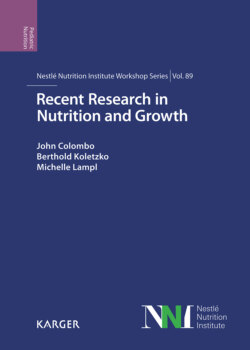Читать книгу Recent Research in Nutrition and Growth - Группа авторов - Страница 42
На сайте Литреса книга снята с продажи.
Regulation of the Perinatal Window Aperture
ОглавлениеThe fundamental mechanism responsible for orchestrating these developmental windows is unclear. Extensive research has implicated significant roles for the IGF and TGF-β families of growth factors in the determination of skeletal muscle mass – the former as a positive regulator and the latter as an inhibitor of muscle growth [27]. IGF-I and -II signaling via the IGF-I receptor (1R) plays a significant role in the regulation of skeletal muscle growth by stimulating muscle protein anabolism and promoting satellite cell proliferation and myonuclear accretion [28]. The importance of the IGFs and the IGF-1R for in vivo muscle growth in early life was demonstrated by the blunted growth that occurred with globally disrupted expression of IGF-I, IGF-II, or IGF-1R [28]. However, it is the locally produced IGFs acting in an autocrine/paracrine mode that are considered to have the predominant influence on muscle growth [29]. This is further supported by the hypertrophic response observed in transgenic muscle-specific IGF-I mouse models [29]. It is highly pertinent, therefore, that the expression rates of IGF-I, IGF-II, and IGF-1R in muscles are high following differentiation and decrease during the maturation phase, attaining a nadir at approximately the same time that myonuclear accretion abates [15]. In contrast, myostatin acts through signaling pathways to blunt the proliferation and differentiation of committed myoblasts, while also inhibiting protein anabolism [27]. The expression of myostatin changes in a reciprocal manner to the IGFs in the developing muscle [30], and it is upregulated in catabolic states associated with muscle wasting. Recently, using genetic mouse models, we demonstrated that in conditions in which myostatin expression is ablated, while IGF-I is overexpressed in muscle, there is a synergistic effect on muscle hypertrophy [27]. This is not dissimilar to the condition of the immature muscle, and, although the significance of such a mechanism in the delineation of the perinatal window of muscle development requires further validation, it is consistent with other examples in which the progress from one step of development to the next is regulated by changes in the balance between positive and negative regulators [31, 32].
